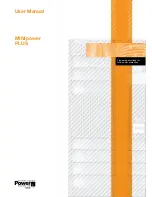
1--2
Powerware 9315 Parallel Capacity/Redundant System with PHP SSBM
164201373 Rev. A
092402
1.1.2
Preparing Your Site
For your Parallel Capacity/Redundant system to operate at peak efficiency, your
installation site should meet the environmental parameters outlined in the
operator’s manual for the SSBM and UPMs. If you intend to operate the system at
an altitude higher than 1500 meters (5000 feet), contact your local sales or service
office for important information about high altitude operation. The operating
environment must meet the size and weight requirements shown in the enclosed
vendor drawings.
The basic environmental requirements for operation of the Parallel
Capacity/Redundant system are:
Ambient Temperature Range:
0---25
˚
C (32---77
˚
F)
Recommended Operating Range:
20---25
˚
C (68---77
˚
F)
Maximum Relative Humidity:
95% noncondensing
The UPM cabinets use forced air cooling to regulate internal component temperature.
The SSBM, battery and optional component cabinets use convection cooling to
regulate internal component temperature. Air inlets are in the front of the cabinet, and
outlets are in the top. You must allow clearance in front of and above each cabinet for
proper air circulation.
1.1.3
Environment Considerations
The life of the Parallel Capacity/Redundant system will be adversely affected if the
installation does not meet the following guidelines:
1.
The system must be installed on a sealed concrete pad or a sealed concrete
floor.
2.
The system must be installed in a temperature-controlled indoor area free of
conductive contaminants.
1.1.4
Preparing for Wiring the Parallel Capacity/Redundant
System
NOTE:
The external wiring and conduit sizings described in this manual are only
provided as a recommended approach. Many design considerations may
require an external wiring and conduit configuration much different than the
examples provided in this manual. Applicable local codes and national
codes must be followed.
Table A in Appendix A covers SSBM and SMB power cabling for a 3
∅
/ 3W
system. Table A is based on the entire 3
∅
/ 3W system being in a
25
_
C
room
ambient and the use of
90
_
C
copper wire. The 500kcmil and 600kcmil cables
are used as examples.
Table B in Appendix A covers SSBM and SMB power cabling for a 3
∅
/ 4W
system. Table B is based on the entire 3
∅
/ 4W system being in a
25
_
C
room
ambient, use of
90
_
C
copper wire and a 0.80 derating factor because there are
more than three current carrying conductors in a raceway (NEC Table 310---16
and Notes). The 500kcmil and 600kcmil cables are used as examples.
















































